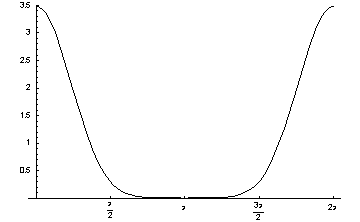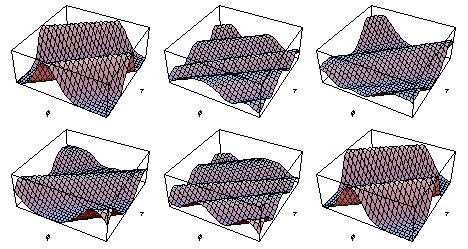
Particle moving on a ring
CH352 Physical Chemistry
Fall 2002
Supplements
Problem sets
Exams
http://www.bu.edu/chemistry/undergrad/courses/352-fall-2002/supplements/RingPacket.html
Updated
Friday, October 24, 2003 4:48 PM
Copyright © 2002 Dan
Dill (dan@bu.edu)
Department
of Chemistry, Boston
University, Boston MA 02215

Here is an animation probability density of a quantum particle moving on a ring. The particle is described by a wavefunction composed of five m values: 8, 9, 10, 11, and 12. The relative weights of the m values fall off symmetrically from m = 10.

The motion covers one period of evolution of the ring. This period is 2 pi time units. One time unit is equal the hbar/(2 m r^2), where m is the mass of the particle and r is the radius of the ring. For an HCl molecule the time unit is 5 x 10^-13 seconds.
Reload this page to replay the animation.
Here are stacks of the time slices, for times over a 0.4 unit range centered at 0, 2 pi/5 (upper row, from left), 4 pi/5, 6 pi/5, 8 pi/5 and 2 pi (lower low, from left).

Details of angular motion in quantum systems and of the construction of such wavepackets are discussed here.
[ Top ]
http://www.bu.edu/chemistry/undergrad/courses/352-fall-2002/supplements/RingPacket.html
Updated
Friday, October 24, 2003 4:48 PM
Dan
Dill (dan@bu.edu)